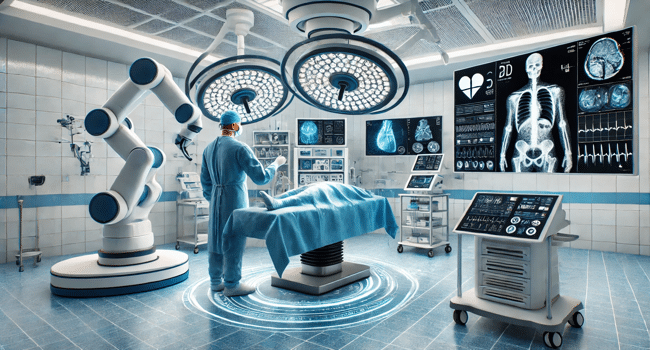Table of Contents
Advancements in medical technology are changing the manner in which medical services experts convey care, guaranteeing improved results and upgraded security for patients going through systems. Whether you’re a patient looking for delicate dentistry, a medical care proficient remaining momentum with industry principles, or a clinical scientist investigating state of the art improvements, the crossing point of innovation and medical services offers tremendous commitment.
This blog jumps into how advancements like mechanical technology, computerized reasoning, and painless imaging changing patient wellbeing during clinical and dental strategies are. From lessening entanglements to advancing accuracy, these advancements are reshaping the patient experience.
Robotics and Precision in Care
Surgical Assistance Robots Enhance Accuracy
Robotic-assisted surgery has emerged as perhaps of the main headway in clinical innovation, offering unrivaled accuracy. These frameworks are presently generally utilized in different clinical fields, including dental medical procedures and muscular health. Their advantages incorporate more modest cuts, diminished blood misfortune, and more limited recuperation times.
One normal model is the da Vinci Careful Framework, which permits specialists to carry out complex techniques through little entry points while keeping up with uncommon control. For dental consideration, mechanical frameworks are currently utilized in putting dental inserts, limiting dangers and further developing results.
Minimizing Human Error
Robots succeed in dreary errands, which lessens the opportunity of human blunder during systems. Mechanized devices for cleansing and readiness of clinical instruments likewise guarantee ideal cleanliness, bringing down the gamble of contamination.
Artificial Intelligence (AI) in Healthcare
Advanced Diagnosis and Risk Assessment
AI plays a crucial role in identifying possible entanglements before strategies even start. For instance, AI calculations dissect patient information, like imaging sweeps and clinical chronicles, to anticipate the probability of dangers during medical procedure. This proactive methodology permits medical care suppliers to go to preparatory lengths and designer techniques to individual necessities.
Artificial intelligence’s job in dentistry is likewise developing. From breaking down X-beams to distinguishing oral medical problems like cavities or bone misfortune early, present day artificial intelligence apparatuses empower techniques that are both more secure and more successful. These developments are especially helpful while arranging medicines, for example, dental inserts, which require high accuracy.
Real-Time Monitoring with AI
Man-made intelligence fueled apparatuses can screen patients progressively during medical procedures and ready experts to expected difficulties, for example, drops in pulse or oxygen levels. This permits prompt mediation, forestalling further issues.
Enhancing Imaging and Diagnostics
Non-Invasive Imaging
Medical imaging has seen tremendous progressions as of late, with advancements like 3D imaging and computerized X-beams offering more clear, more definite experiences. These developments help in conclusion as well as guide complex methodology with more noteworthy exactness.
For example, Cone Bar Registered Tomography (CBCT) is progressively utilized in dental methodology like dental implants in Las Vegas. CBCT scans give a 3D perspective on a patient’s oral design, empowering exact implantation while limiting dangers, for example, nerve harm.
Radiation Reduction Technology
Conventional imaging procedures frequently open patients to huge degrees of radiation. In any case, new progressions in imaging have definitely decreased these openings, guaranteeing more noteworthy wellbeing, especially for techniques that require successive imaging, for example, orthodontic check-ups or pre-careful arrangements.
Digital Tools for Enhanced Patient Communication
Electronic Health Records (EHR)
The joining of EHR frameworks upgrades correspondence between clinical experts and guarantees a total comprehension of a patient’s clinical foundation. Admittance to this data limits blunders and further develops care coordination during methods, particularly for patients with complex clinical chronicles.
Virtual Reality (VR) for Patient Education
Computer generated Reality (VR) innovation has been instrumental in planning patients for techniques, especially for those with nervousness. By offering VR reproductions that make sense of cycles bit by bit, patients gain a superior comprehension of what’s in store, which lightens dread and fabricates trust in medical services experts.
Application of Wearables and IoT
Continuous Monitoring with Wearable Devices
Wearable gadgets, for example, pulse screens and oxygen immersion trackers are turning out to be progressively normal in medical services settings. These gadgets give doctors continuous bits of knowledge into a patient’s important bodily functions during methods, permitting them to rapidly go with informed choices.
IoT for Connected Operating Rooms
The Web of Things (IoT) coordinates different gadgets in a working room, empowering consistent correspondence between checking frameworks, automated gadgets, and careful gear. This interconnected environment upgrades accuracy and effectiveness while keeping up with patient security.
Promoting a Culture of Safety with Technology
Innovation guarantees security during systems as well as energizes a more extensive culture of wellbeing inside medical services associations. Via computerizing preparing modules, helping staff to remember cleanliness conventions, and offering moment criticism during methodology, innovation upholds clinical experts in keeping up with the best expectations of care.
New Horizons in Patient Safety
From computerizing routine cycles to directing complex medical procedures, innovation has reclassified how clinical and dental methodology are performed. For medical services experts and patients the same, these advancements mean more limited recuperation times, decreased chances, and further developed results.
As headways like man-made intelligence, advanced mechanics, and associated gadgets keep on developing, what’s in store holds tremendous potential for guaranteeing more secure and more effective medical care for all.
Read more on KulFiy
